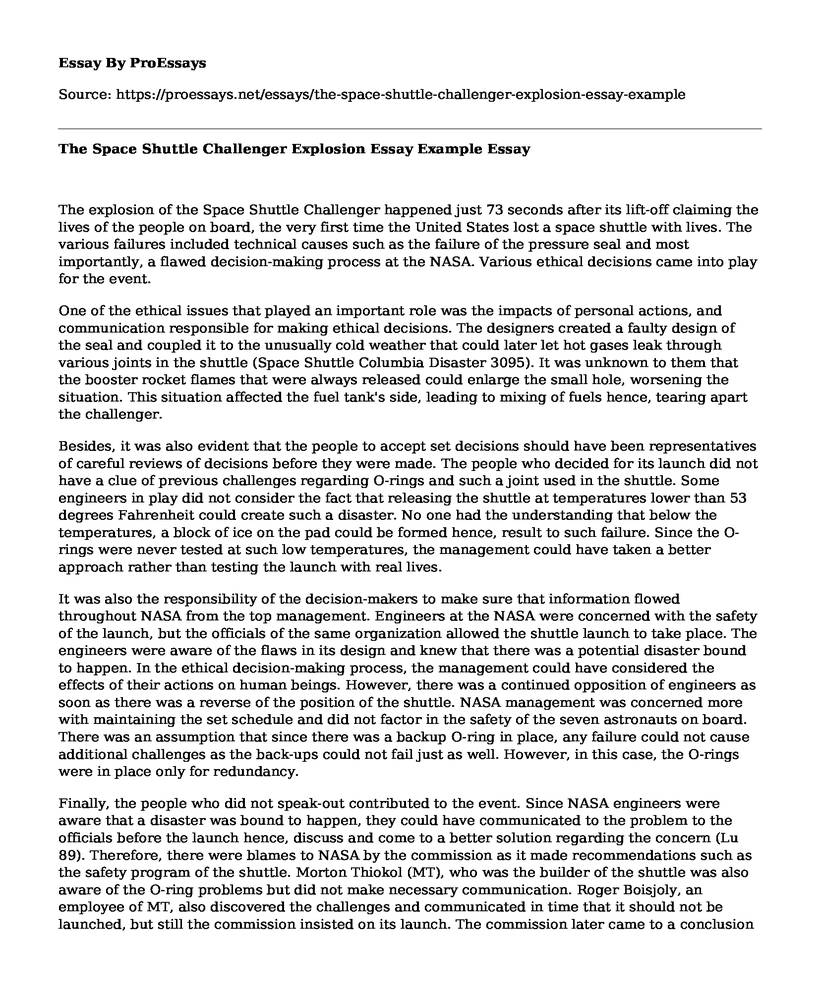The explosion of the Space Shuttle Challenger happened just 73 seconds after its lift-off claiming the lives of the people on board, the very first time the United States lost a space shuttle with lives. The various failures included technical causes such as the failure of the pressure seal and most importantly, a flawed decision-making process at the NASA. Various ethical decisions came into play for the event.
One of the ethical issues that played an important role was the impacts of personal actions, and communication responsible for making ethical decisions. The designers created a faulty design of the seal and coupled it to the unusually cold weather that could later let hot gases leak through various joints in the shuttle (Space Shuttle Columbia Disaster 3095). It was unknown to them that the booster rocket flames that were always released could enlarge the small hole, worsening the situation. This situation affected the fuel tank's side, leading to mixing of fuels hence, tearing apart the challenger.
Besides, it was also evident that the people to accept set decisions should have been representatives of careful reviews of decisions before they were made. The people who decided for its launch did not have a clue of previous challenges regarding O-rings and such a joint used in the shuttle. Some engineers in play did not consider the fact that releasing the shuttle at temperatures lower than 53 degrees Fahrenheit could create such a disaster. No one had the understanding that below the temperatures, a block of ice on the pad could be formed hence, result to such failure. Since the O-rings were never tested at such low temperatures, the management could have taken a better approach rather than testing the launch with real lives.
It was also the responsibility of the decision-makers to make sure that information flowed throughout NASA from the top management. Engineers at the NASA were concerned with the safety of the launch, but the officials of the same organization allowed the shuttle launch to take place. The engineers were aware of the flaws in its design and knew that there was a potential disaster bound to happen. In the ethical decision-making process, the management could have considered the effects of their actions on human beings. However, there was a continued opposition of engineers as soon as there was a reverse of the position of the shuttle. NASA management was concerned more with maintaining the set schedule and did not factor in the safety of the seven astronauts on board. There was an assumption that since there was a backup O-ring in place, any failure could not cause additional challenges as the back-ups could not fail just as well. However, in this case, the O-rings were in place only for redundancy.
Finally, the people who did not speak-out contributed to the event. Since NASA engineers were aware that a disaster was bound to happen, they could have communicated to the problem to the officials before the launch hence, discuss and come to a better solution regarding the concern (Lu 89). Therefore, there were blames to NASA by the commission as it made recommendations such as the safety program of the shuttle. Morton Thiokol (MT), who was the builder of the shuttle was also aware of the O-ring problems but did not make necessary communication. Roger Boisjoly, an employee of MT, also discovered the challenges and communicated in time that it should not be launched, but still the commission insisted on its launch. The commission later came to a conclusion of the flawed decision-making on behalf of NASA.
Works cited
"Space Shuttle Columbia Disaster." Lees Loss Prevention in the Process Industries, 2012, pp. 3093-3097., doi:10.1016/b978-0-12-397189-0.00117-8.
Lu, Xiaoli. "NASA and the Space Shuttle Columbia Disaster: An Institution Coping with 'Unknown Unknowns.'" Managing Uncertainty in Crisis, 2017, pp. 85-111., doi:10.1007/978-981-10-3990-4_5.
Cite this page
The Space Shuttle Challenger Explosion Essay Example. (2022, Aug 23). Retrieved from https://proessays.net/essays/the-space-shuttle-challenger-explosion-essay-example
If you are the original author of this essay and no longer wish to have it published on the ProEssays website, please click below to request its removal:
- Course Work Sample: The Effects of Dissolved Oxygen on Fish Growth
- Time Difference of Arrival and Ray Tracing Propagation Methods
- Chemistry of Fresco - Paper Example
- Nature of Magnetic Surfactants Essay Example
- Euler and the Function Concept and Philosophy of Mathematics Essay
- Illinois State Geological Symbols: Essential for US Economy - Essay Sample
- Essay Example on Geography: Location, Place, and Region Explored







